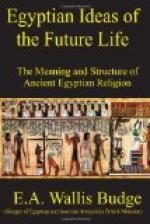“God is father and mother, the father of fathers, and the mother of mothers. He begetteth, but was never begotten; He produceth, but was never produced He begat Himself and produced Himself. He createth, but was never created; He is the maker of His own form, and the fashioner of His own body.
“God Himself is existence He liveth in all things, and liveth upon all things. He endureth without increase or diminution, He multiplieth Himself millions of times, and He possesseth multitudes of forms and multitudes of members.
“God hath made the universe, and He hath created all that therein is: He is the Creator of what is in this world, of what was, of what is, and of what shall be. He is the Creator of the world, and it was He Who fashioned it with His hands before there was any beginning; and He stablished it with that which went forth from Him. He is the Creator of the heavens and the earth; the Creator of the heavens, and the earth, and the deep; the Creator of the heavens, and the earth, and the deep, and the waters, and the mountains. God hath stretched out the heavens and founded the earth. What His heart conceived came to pass straightway, and when He had spoken His word came to pass, and it shall endure for ever.
“God is the father of the gods, and the father of the father of all deities; He made His voice to sound, and the deities came into being, and the gods sprang into existence after He had spoken with His mouth. He formed mankind and fashioned the gods. He is the great Master, the primeval Potter Who turned men and gods out of His hands, and He formed men and gods upon a potter’s table.
“The heavens rest upon His head, and the earth supporteth His feet; heaven hideth His spirit, the earth hideth His form, and the underworld shutteth up the mystery of Him within it. His body is like the air, heaven resteth upon His head, and the new inundation [of the Nile] containeth His form.
“God is merciful unto those who reverence Him, and He heareth him that calleth upon Him. He protecteth the weak against the strong, and He heareth the cry of him that is bound in fetters; He judgeth between the mighty and the weak, God knoweth him that knoweth Him, He rewardeth him that serveth Him, and He protecteth him that followeth Him.”
We have now to consider the visible emblem, and the type and symbol of God, namely the Sun-god R[=a], who was worshipped in Egypt in prehistoric times. According to the writings of the Egyptians, there was a time when neither heaven nor earth existed, and when nothing had being except the boundless primeval [Footnote: See Brugsch, Religion, p. 101.] water, which was, however, shrouded with thick darkness. In this condition the primeval water remained for a considerable time, notwithstanding that it contained within it the germs of the things which afterwards came into




